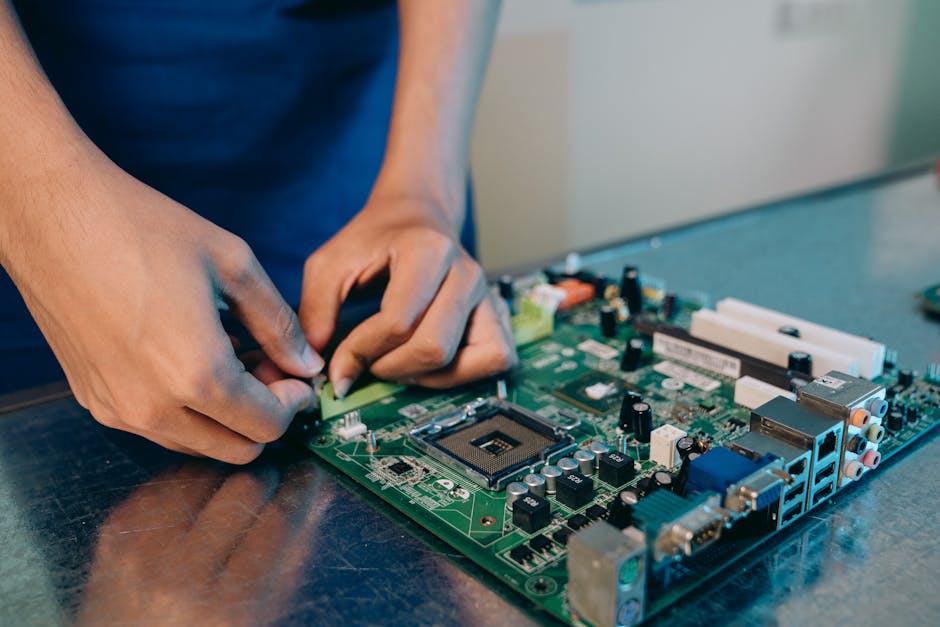Apple’s ELEGNT framework could make home robots feel less like machines and more like companions - Related to pricing?, companions, robots, less, targets
Apple’s ELEGNT framework could make home robots feel less like machines and more like companions

Apple researchers have developed a new framework for making non-humanoid robots move more naturally and expressively during interactions with people, potentially paving the way for more engaging robotic assistants in homes and workplaces.
The research, , introduces Expressive and Functional Movement Design ELEGNT, which allows robots to convey intentions, emotions and attitudes through their movements — rather than just completing functional tasks.
“For robots to interact more naturally with humans, robot movement design should integrate expressive qualities — such as intention, attention and emotions — alongside traditional functional considerations like task fulfillment, spatial constraints and time efficiency,” the researchers from Apple’s robotics team write in their research paper.
How a desk lamp became the perfect test subject for robot emotions.
The study focused on a lamp-like robot, reminiscent of Pixar’s animated Luxo Jr. character, equipped with a 6-axis robotic arm and a head containing a light and projector. The researchers programmed the robot with two types of movements: purely functional ones focused on completing tasks, and more expressive movements designed to communicate the robot’s internal state.
In user testing with 21 participants, the expressive movements significantly improved people’s engagement with and perception of the robot. This effect was especially pronounced during social tasks like playing music or engaging in conversation, although it was less impactful for purely functional tasks like adjusting lighting.
“Without the playfulness, I might find this type of interaction with a robot annoying rather than welcome and engaging,” noted one study participant, highlighting how expressive movements made even potentially intrusive robot behaviors more acceptable.
A visual guide showing the expressive movement vocabulary developed for the lamp-like robot, including basic gestures and spatial behaviors. (Credit: Apple).
User testing reveals age gap in robot movement preferences.
The research comes as major tech companies increasingly explore home robotics. While most current home robots like robot vacuums focus purely on function, this work indicates that adding more natural, expressive movements could make future robots more appealing companions.
However, the researchers note that balance is crucial. “There needs to be a balance between engagement through motion and speed completion of the task being given, otherwise the human might grow impatient,” one participant observed.
The study also found that older participants were significantly less receptive to expressive robot movements, suggesting that robot behavior may need to be customized based on user preferences.
The robot’s capabilities span from functional tasks like providing reading light to social interactions such as creative suggestions and playful companionship. (Credit: Apple).
The future of social robotics: Finding the sweet spot between function and expression.
While Apple rarely discusses its robotics research publicly, this work offers intriguing hints about how the tech giant might approach future home robots. The study indicates a fundamental shift in robotics design: Instead of focusing solely on what robots can do, companies must consider how robots make people feel.
The challenge ahead lies not just in programming robots to complete tasks, but in making their presence welcome in our most intimate spaces. As robots transition from factory floors to living rooms, their success may depend less on raw efficiency and more on their ability to read the room — both literally and metaphorically.
Apple’s paper will be presented at the 2025 Designing Interactive Systems conference in Madeira this July.
The results point to a future where robot design requires as much input from animators and behavioral psychologists as it does from engineers.
As robots become more common in homes and workplaces, making them move in ways that feel natural rather than mechanical could be the difference between another forgotten gadget and a truly indispensable companion. The real test will be whether companies like Apple can translate these research insights into products that people not only use, but genuinely want to interact with.
Day one of MLDS 2025, India’s biggest GenAI summit for developers, hosted by AIM Media House, was a day filled with energy, excitement, and forward-th...
Microsoft PowerBI is a one of the most popular Business Intelligence (BI) tools, and while it has all the capabilities you need to create dynamic analytic...
Google DeepMind spinoff Isomorphic Labs expects testing on its first AI-designed drugs to begin this year, as tech startups race to turn algorithmic m...
As Sam Altman Returns to India, Will OpenAI Offer Region-Specific AI Pricing?

OpenAI CEO Sam Altman is set to visit India for the second time this Wednesday. His Asia tour has already seen several product launches so far and his upcoming visit to India is expected to bring key announcements tailored to the country’s unique needs.
India, with its vast user base, is a prime candidate for simpler, more accessible ChatGPT interfaces tailored to local needs. In this light, OpenAI’s announcement last December about adding a phone-calling feature to ChatGPT is particularly exciting. It removes the need for an internet connection or high-end devices, meaning even clients with basic flip phones or rotary phones will have access to AI assistance.
“1-800-ChatGPT might seem like a silly gimmick, but the underlying principle is critical to scaling AI adoption,” wrote Google Deepmind’s Logan Kilpatrick on X. If implemented well, a feature like this will be a huge win for accessibility in developing countries.
“The next billion AI customers will not be on the existing UX’s, they will be using text, email, and voice,” he added, suggesting whoever lands this experience is going to win in a huge way.
A mail sent to OpenAI did not elicit any response about the specifics of the phone-calling feature’s rollout in India.
“One of the most significant advantages of such integration is its ability to empower consumers,” added Osama Manzar, founder and director of the Digital Empowerment Foundation.
By enabling people to create content, search for information, and share ideas, through voice commands, ChatGPT could make technology more accessible to those with limited digital literacy. This would be particularly impactful for rural and non-internet individuals, opening up new opportunities for learning, communication, and accessing essential services.
“However, there are critical challenges to consider. The first concern is the contextual relevance of the AI’s responses. ChatGPT’s backend systems may not always adapt well to the diverse linguistic and cultural needs of local communities,” he added, commenting that misalignment could reduce effectiveness and drive individuals away.
Manzar also raised concerns about data privacy, as consumers may unknowingly share information without understanding how it’s stored or used.
From 2008 to 2024, active SIM cards in India surged over threefold, surpassing one billion in a population of [website] billion, underlining the immense potential for AI adoption at scale in the country. From a regulatory perspective, OpenAI can introduce such a feature as long as it complies with the relevant data privacy laws in India.
essential to note that AI still remains a relatively new phenomenon in the country, unlike the internet. Beyond chatbots, intuitive design is key to making it accessible and human-centric.
Developing AI solutions tailored to India’s needs and cultural context is imperative.
“The key lies in leveraging existing platforms that are already deeply engaging Indian masses like WhatsApp, Google, and Facebook,” unveiled Manzar.
Despite the success of ChatGPT, it is interesting to observe that apps such as WhatsApp and YouTube continue to be the most popular in the country.
“It is crucial to focus on how we can mine and utilise data generated on these platforms to create AI solutions that are not dominated by foreign tech giants, who might appropriate Indian content for their own benefit,” he added.
While AI accessibility is improving, true adoption in India hinges on both usability and affordability. Simplified interfaces help, but without cost-effective pricing, AI may remain out of reach for many.
The implications of high-cost and premium pricing models for advanced tools are huge in a price-sensitive country like India.
DeepSeek is slowly changing the game for everyone, forcing the AI labs to introduce cheap and open-source alternatives or at least rethink their strategy going forward.
For instance, OpenAI now offers ChatGPT Pro at $200/month and is rumoured to introduce plans up to $2,000/month due to high compute costs of advanced models.
While economics often sees costs decrease over time. Many people responded to Altman on X, highlighting that in the current realm, $200 per month is comparable to salaries and average incomes in many economies outside the US – suggesting that AI subscription pricing cannot be the same globally. In India, for instance, the average monthly income is around ₹20,000.
This puts into perspective that AGI is accessible to the common man. essential part of daily life for many in India and worldwide. More so, as ChatGPT continues to become an essential part of many people’s lives in the country and the world, at least in the urban parts.
Interesting to note, Altman lately conceded on the future of AI ultimately being open-source. “I personally think we have been on the wrong side of history here and need to figure out a different open-source strategy,” Altman noted in a recent AMA session on Reddit. “Not everyone at OpenAI shares this view,” he added.
Closer home, the key question remains: Can India achieve its own free, open-source DeepSeek equivalent? More so, with a focus on Indic datasets.
Aravind Srinivas, CEO of Perplexity, urged that building a foundational model in the country is as significant as building on the application layer. Much is written about how the internet is divided on this question. Infosys co-founder Nandan Nilekani and former People + AI head Tanuj Bojwani have advocated to really solve Indian problems through use cases.
Ola chief Bhavish Aggarwal has introduced Krutrim AI Lab and the launch of several open-source AI models tailored to India’s unique linguistic and cultural landscape. This announcement aligns with India’s broader AI ambitions. The government has officially called for proposals to develop homegrown AI models, marking a decisive push toward sovereign AI that can compete globally.
Through the IndiaAI Mission, startups, researchers, and entrepreneurs are invited to build large multimodal models, large language models, and small language models, ensuring AI that is deeply rooted in India’s languages and culture. Per the website, the government expects the models must be trained on diverse Indian datasets, comply with Indian regulations, and serve both public and strategic interests.
Tata Communications, India’s leading tech business, has partnered with [website], a conversational AI platform, to bring Sovereign AI solutions to Ind...
UK startup PhysicsX, founded by former Formula 1 engineering whizz Robin “Dr. Rob” Tuluie, has unveiled an AI tool that could fast-track the time it t...
People use tables every day to organize and interpret complex information in a structured, easily accessible format. Due to the ubiquity of such table...
Europe accelerates AI drug discovery as DeepMind spinoff targets trials this year

Google DeepMind spinoff Isomorphic Labs expects testing on its first AI-designed drugs to begin this year, as tech startups race to turn algorithmic magic into actual treatments.
“We’ll hopefully have some AI-designed drugs in clinical trials by the end of the year,” the firm’s Nobel Prize-winning CEO Demis Hassabis told a panel at the World Economic Forum in Davos this week. “That’s the plan.”.
The potential of AI-powered drug discovery is huge. Instead of spending years or even decades testing chemicals by hand, machine learning algorithms can sift through mountains of data to spot patterns and predict which molecules could make the next miracle drug. This could lead to faster drug development, cheaper costs, and new cures.
By one estimate, there are over 460 AI startups currently working on drug discovery, of which over a quarter come from Europe. Globally, more than $60bn has been invested into the space so far, and the funding flood isn’t showing any signs of letting up.
Yet discovering the drugs is merely one step in the process. it’s only when big pharma decides they’re worth manufacturing, marketing, and distributing that it’ll make a real difference to the likes of you and me.
That’s what makes some of the recent hookups between pharma behemoths and AI startups particularly exciting.
Last year, Isomorphic Labs inked a $45mn deal with Eli Lilly to collaborate on AI-based research into small molecule therapeutics. Under the agreement, Isomorphic is also eligible to receive up to $[website] in “performance-based milestones.” The business also signed a similar collaboration with Swiss biotech Novartis.
“We’re already working on real drug programs,” Hassabis told Bloomberg Television in an interview shortly following the announcements. “I would expect in the next couple of years the first AI-designed drugs in the clinic.”.
Exscientia, which spun out from Dundee University in 2012, was among the first to apply AI to drug discovery. In 2024, the enterprise advanced its first AI-designed drug candidate into human clinical trials, achieving this milestone in just 12 months — a process that typically takes around five years. US rival Recursion acquired the Oxford-based enterprise for $688mn in November.
These are two big examples of an AI-driven drug discovery market that’s booming, and increasingly, consolidating. However, there are also plenty of early-stage companies working on more niche applications of the technology. These include Cambridge, UK-based CardiaTec, which is using AI to find new drugs to treat heart conditions, and London-headquartered Multiomic Health, which is working on formulas to treat metabolic diseases.
Despite all the potential though, AI isn’t a silver bullet for drug discovery. While it can drastically speed up finding the right compounds needed to make new drugs, the most time-consuming steps — like wet lab tests with physical samples, clinical trials, and FDA approvals — aren’t going anywhere. Still, AI’s real power lies in that critical first phase: zeroing in on targets that might’ve otherwise slipped through the cracks, saving researchers time and possibly even unlocking new treatments.
Floods are the most common natural disaster, and are responsible for roughly $50 billion in annual financial damages worldwide. The rate of flood-rela...
The Dutch government has reached a deal with Nvidia to supply hardware and expertise for the construction of an AI facility in the Netherlands.
Market Impact Analysis
Market Growth Trend
| 2018 | 2019 | 2020 | 2021 | 2022 | 2023 | 2024 |
|---|---|---|---|---|---|---|
| 23.1% | 27.8% | 29.2% | 32.4% | 34.2% | 35.2% | 35.6% |
Quarterly Growth Rate
| Q1 2024 | Q2 2024 | Q3 2024 | Q4 2024 |
|---|---|---|---|
| 32.5% | 34.8% | 36.2% | 35.6% |
Market Segments and Growth Drivers
| Segment | Market Share | Growth Rate |
|---|---|---|
| Machine Learning | 29% | 38.4% |
| Computer Vision | 18% | 35.7% |
| Natural Language Processing | 24% | 41.5% |
| Robotics | 15% | 22.3% |
| Other AI Technologies | 14% | 31.8% |
Technology Maturity Curve
Different technologies within the ecosystem are at varying stages of maturity:
Competitive Landscape Analysis
| Company | Market Share |
|---|---|
| Google AI | 18.3% |
| Microsoft AI | 15.7% |
| IBM Watson | 11.2% |
| Amazon AI | 9.8% |
| OpenAI | 8.4% |
Future Outlook and Predictions
The Like Apple Elegnt landscape is evolving rapidly, driven by technological advancements, changing threat vectors, and shifting business requirements. Based on current trends and expert analyses, we can anticipate several significant developments across different time horizons:
Year-by-Year Technology Evolution
Based on current trajectory and expert analyses, we can project the following development timeline:
Technology Maturity Curve
Different technologies within the ecosystem are at varying stages of maturity, influencing adoption timelines and investment priorities:
Innovation Trigger
- Generative AI for specialized domains
- Blockchain for supply chain verification
Peak of Inflated Expectations
- Digital twins for business processes
- Quantum-resistant cryptography
Trough of Disillusionment
- Consumer AR/VR applications
- General-purpose blockchain
Slope of Enlightenment
- AI-driven analytics
- Edge computing
Plateau of Productivity
- Cloud infrastructure
- Mobile applications
Technology Evolution Timeline
- Improved generative models
- specialized AI applications
- AI-human collaboration systems
- multimodal AI platforms
- General AI capabilities
- AI-driven scientific breakthroughs
Expert Perspectives
Leading experts in the ai tech sector provide diverse perspectives on how the landscape will evolve over the coming years:
"The next frontier is AI systems that can reason across modalities and domains with minimal human guidance."
— AI Researcher
"Organizations that develop effective AI governance frameworks will gain competitive advantage."
— Industry Analyst
"The AI talent gap remains a critical barrier to implementation for most enterprises."
— Chief AI Officer
Areas of Expert Consensus
- Acceleration of Innovation: The pace of technological evolution will continue to increase
- Practical Integration: Focus will shift from proof-of-concept to operational deployment
- Human-Technology Partnership: Most effective implementations will optimize human-machine collaboration
- Regulatory Influence: Regulatory frameworks will increasingly shape technology development
Short-Term Outlook (1-2 Years)
In the immediate future, organizations will focus on implementing and optimizing currently available technologies to address pressing ai tech challenges:
- Improved generative models
- specialized AI applications
- enhanced AI ethics frameworks
These developments will be characterized by incremental improvements to existing frameworks rather than revolutionary changes, with emphasis on practical deployment and measurable outcomes.
Mid-Term Outlook (3-5 Years)
As technologies mature and organizations adapt, more substantial transformations will emerge in how security is approached and implemented:
- AI-human collaboration systems
- multimodal AI platforms
- democratized AI development
This period will see significant changes in security architecture and operational models, with increasing automation and integration between previously siloed security functions. Organizations will shift from reactive to proactive security postures.
Long-Term Outlook (5+ Years)
Looking further ahead, more fundamental shifts will reshape how cybersecurity is conceptualized and implemented across digital ecosystems:
- General AI capabilities
- AI-driven scientific breakthroughs
- new computing paradigms
These long-term developments will likely require significant technical breakthroughs, new regulatory frameworks, and evolution in how organizations approach security as a fundamental business function rather than a technical discipline.
Key Risk Factors and Uncertainties
Several critical factors could significantly impact the trajectory of ai tech evolution:
Organizations should monitor these factors closely and develop contingency strategies to mitigate potential negative impacts on technology implementation timelines.
Alternative Future Scenarios
The evolution of technology can follow different paths depending on various factors including regulatory developments, investment trends, technological breakthroughs, and market adoption. We analyze three potential scenarios:
Optimistic Scenario
Responsible AI driving innovation while minimizing societal disruption
Key Drivers: Supportive regulatory environment, significant research breakthroughs, strong market incentives, and rapid user adoption.
Probability: 25-30%
Base Case Scenario
Incremental adoption with mixed societal impacts and ongoing ethical challenges
Key Drivers: Balanced regulatory approach, steady technological progress, and selective implementation based on clear ROI.
Probability: 50-60%
Conservative Scenario
Technical and ethical barriers creating significant implementation challenges
Key Drivers: Restrictive regulations, technical limitations, implementation challenges, and risk-averse organizational cultures.
Probability: 15-20%
Scenario Comparison Matrix
| Factor | Optimistic | Base Case | Conservative |
|---|---|---|---|
| Implementation Timeline | Accelerated | Steady | Delayed |
| Market Adoption | Widespread | Selective | Limited |
| Technology Evolution | Rapid | Progressive | Incremental |
| Regulatory Environment | Supportive | Balanced | Restrictive |
| Business Impact | Transformative | Significant | Modest |
Transformational Impact
Redefinition of knowledge work, automation of creative processes. This evolution will necessitate significant changes in organizational structures, talent development, and strategic planning processes.
The convergence of multiple technological trends—including artificial intelligence, quantum computing, and ubiquitous connectivity—will create both unprecedented security challenges and innovative defensive capabilities.
Implementation Challenges
Ethical concerns, computing resource limitations, talent shortages. Organizations will need to develop comprehensive change management strategies to successfully navigate these transitions.
Regulatory uncertainty, particularly around emerging technologies like AI in security applications, will require flexible security architectures that can adapt to evolving compliance requirements.
Key Innovations to Watch
Multimodal learning, resource-efficient AI, transparent decision systems. Organizations should monitor these developments closely to maintain competitive advantages and effective security postures.
Strategic investments in research partnerships, technology pilots, and talent development will position forward-thinking organizations to leverage these innovations early in their development cycle.
Technical Glossary
Key technical terms and definitions to help understand the technologies discussed in this article.
Understanding the following technical concepts is essential for grasping the full implications of the security threats and defensive measures discussed in this article. These definitions provide context for both technical and non-technical readers.


